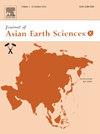Origin and evolution of serpentinized peridotite from the Ciletuh Mélange in Sunda Arc, Indonesia: Evidence from petrography, mineralogy, and geochemistry
IF 2.3
Q3 GEOSCIENCES, MULTIDISCIPLINARY
引用次数: 0
Abstract
The Ciletuh Mélange in southern Sundaland (West Java, Indonesia) is a key location for ophiolitic mélanges, featuring widespread serpentinized peridotite. These rocks exhibit varied textures and structures and can be classified into three types based on the extent of serpentinization: type 1 (lherzolite, <10 % serpentinization), type 2 (60–80 % serpentinization), and type 3 (>90 % serpentinization). Olivine and spinel mineral chemistry indicates two origins for the peridotite: magmatic cumulate (type 1, olivine Fo#: ∼81, spinel Cr#: 63–70) and mantle-derived (types 2 and 3, olivine Fo: 88–90, spinel Cr#: 55–66). Protoliths of both types 2 and 3 show abyssal (mid-oceanic ridge basalt) and fore-arc mantle peridotite characteristics, formed by partial melting (∼5–25 %) and melt-rock interaction (TiO2 in spinel > 1 wt%). Type 1 lherzolite, by contrast, crystallized as a cumulate at the mantle-crust boundary. The variation of geochemical signatures, along with evidence of melt influence, suggest formation in a supra-subduction zone. In subduction systems, the protoliths underwent serpentinization at varying metamorphic grades, producing serpentines such as lizardite, antigorite, chrysotile, and polygonal serpentine. Antigorite formed under high-grade metamorphism, while lizardite, chrysotile, and polygonal serpentine form under lower-grade conditions. The presence of rodingite dikes cutting through serpentinite suggests metasomatic processes, notably rodingitization, involving diffusional metasomatism between serpentinization fluids and metamorphosed gabbro in the subduction zone. Serpentinized peridotites and rodingites were later exhumed as part of the ophiolitic mélange.
印度尼西亚巽他弧Ciletuh m兰格蛇纹石橄榄岩的起源和演化:岩石学、矿物学和地球化学证据
Sundaland南部(印度尼西亚西爪哇)的Ciletuh msamuange是蛇绿质msamuange的关键位置,具有广泛的蛇纹石化橄榄岩。这些岩石具有不同的结构和结构,根据蛇纹岩化程度可分为3种类型:1型(lzolite, <; 10%蛇纹岩化)、2型(60 - 80%蛇纹岩化)和3型(>; 90%蛇纹岩化)。橄榄石和尖晶石矿物化学表明橄榄岩有两种成因:岩浆堆积型(1型橄榄石Fo#: ~ 81,尖晶石Cr#: 63 ~ 70)和幔源型(2型和3型橄榄石Fo: 88 ~ 90,尖晶石Cr#: 55 ~ 66)。2型和3型原岩均表现深海(洋中脊玄武岩)和弧前地幔橄榄岩特征,由部分熔融(~ 5 - 25%)和熔融岩相互作用(尖晶石中的TiO2 >;1 wt %)。相比之下,1型辉橄榄岩在幔壳边界以堆积形式结晶。地球化学特征的变化以及熔体影响的证据表明,形成于一个超俯冲带。在俯冲体系中,原岩经历了不同变质等级的蛇纹岩化,形成了蛇纹岩,如蛇纹岩、反长岩、温石棉和多边形蛇纹岩。反长辉石形成于高变质条件下,而蜥蜴石、温石棉和多边形蛇纹石则形成于低变质条件下。蛇纹岩岩脉穿过蛇纹岩的存在表明,在俯冲带内,蛇纹岩化流体与变质辉长岩之间发生了扩散交代作用,主要表现为蛇纹岩化作用。蛇纹橄榄岩和岩纹岩后来作为蛇绿岩的一部分被发掘出来。
本文章由计算机程序翻译,如有差异,请以英文原文为准。
求助全文
约1分钟内获得全文
求助全文
来源期刊

Journal of Asian Earth Sciences: X
Earth and Planetary Sciences-Earth-Surface Processes
CiteScore
3.40
自引率
0.00%
发文量
53
审稿时长
28 weeks
 求助内容:
求助内容: 应助结果提醒方式:
应助结果提醒方式:


